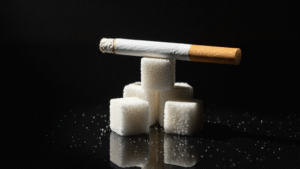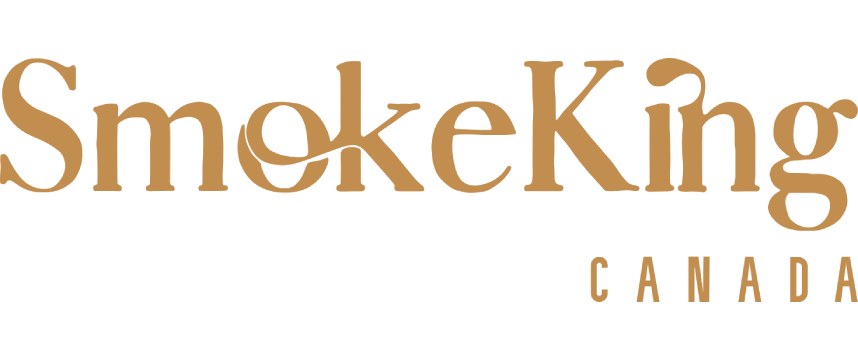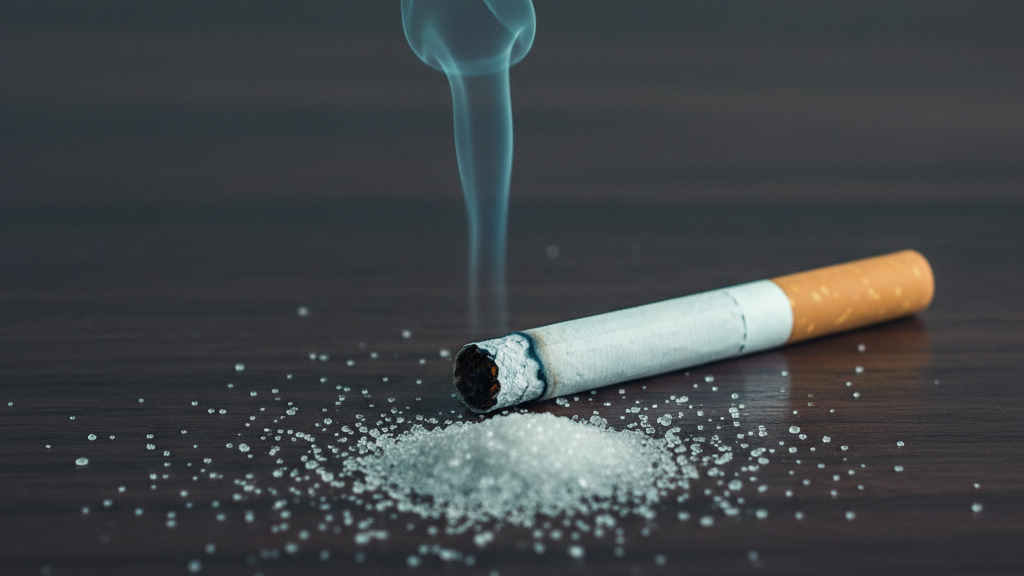Yes, most cigarettes contain added sugar—typically between “≤ about 5% (for American-blend cigarettes, this is the share of added sugars by tobacco weight; total sugars—natural + added—can reach ~10–20%)” of the tobacco’s weight. Tobacco companies add these sugars during manufacturing to make cigarettes taste smoother and less harsh. At the same time, you might not taste sweetness when smoking, that sugar is there, burning alongside the tobacco and creating additional chemical compounds. This practice isn’t new; manufacturers have been adding sugar to cigarettes for decades to make their products more palatable and appealing to smokers.
Understanding what’s actually in cigarettes matters for anyone who smokes or is considering different types of cigarettes. This article breaks down how much sugar different cigarette varieties contain, why manufacturers add it, and what it means for your health. We’ll look at specific cigarette brands in Canada and explain what menthol is in cigarettes and how it relates to sugar content.
How Much Sugar Do Different Types of Cigarettes Contain?
The sugar content varies significantly depending on which types of cigarettes you’re smoking. Manufacturers adjust these levels based on the cigarette style and target market, creating distinct differences across product lines.
Sugar Content Comparison Table:
| Cigarette Type | Sugar Per Cigarette | Sugar as % of Tobacco Weight | Key Characteristics |
| Regular Cigarettes | “up to ≈≤35 mg of added sugar/cigarette (assuming ~0.7 g tobacco per cigarette and ≤5% added sugar)” | “added sugar ≤≈5% (total sugars typically ≈10–20%)” | Standard sugar addition |
| Light Cigarettes | “up to ≈≤35 mg of added sugar/cigarette (no consistent, fixed reduction vs. ‘regular’)” | “added sugar ≤≈5% (total sugars typically ≈10–20%)” | Slightly lower sugar |
| Ultra-Light Cigarettes | “up to ≈≤35 mg of added sugar/cigarette (the ‘ultra-light’ label does not reliably map to sugar level)” | “added sugar ≤≈5% (total sugars typically ≈10–20%)” | Minimal sugar addition |
| Menthol Cigarettes | “may contain added sugar; menthol is a separate additive (added sugar can be ≤≈5%)” | “added sugar ≤≈5% (note: Canada has banned menthol flavoring)” | Sugar plus menthol additives |
| Natural/Additive-Free Cigarettes | “0 mg added sugar/cigarette (no added ≠ no natural sugars)” | “added sugar 0%; natural sugars can still be ≈10–20%“ | Little to no added sugar |
What Is Menthol in Tobacco?
Menthol is the stuff you get from mint plants that gives you a cool feeling and makes smoking feel less harsh. It’s not sugar—just a different flavor thing. However, “some U.S. menthol variants have shown higher added sugar in brand analyses, but the claim ‘menthols typically have the most sugar’ isn’t consistently evidenced; and in Canada, menthol as a flavoring in cigarettes is banned.” The menthol cools it down, while the sugar makes it smoother, so these cigs are easier on the throat.
Most of the regular cigarettes contain sugar, and it can range from “(counting added sugar) up to ~≤35 mg per cigarette; not ‘per puff’.” Menthol smokes contain the “may have added sugar comparable to non-menthols; not consistently the ‘highest'”, and the ones that claim they’re “natural” or “additive-free” have no added sugar, but still contain natural sugars.” Even the light and ultra-light contain “potential added sugar where permitted; ‘light/ultra-light’ does not mean inherently less sugar”—just in slightly lower proportions than regular cigarettes. The cigarette manufacturers add sugar to almost all their brands, “but in Canada, ‘sugars and sweeteners’ as additives are banned (with a narrow exception to replace sugars lost during curing).” Due to this finding completely sugar-free brands is rather rare.

How do They Use Sugar Additives in Canadian Cigarette Brands
Canadian cigarette makers emulate the same procedure as manufacturers globally in terms of sugar in their cigarette products. Canada’s regulation, though, presents some peculiar features that need a closer look.
Industry Practices (How Sugar Is Added)
In Canada, the large cigarette manufacturers actually add sugar to their cigarettes as a regular ingredient. “At the national level in Canada: ‘sugars and sweeteners’ as additives in cigarettes are listed as prohibited under the Tobacco and Vaping Products Act (TVPA) schedules (with a limited exception to replace sugars lost during curing); companies must still report ingredients to Health Canada.” They add sugar to the tobacco before rolling the cigarettes to ensure it’s evenly distributed. As you smoke, that sugar caramelizes and changes the characteristics of the smoke, making it slightly easier to inhale.
Canada’s Rules and Disclosure
Canada makes tobacco companies tell Health Canada about all the stuff they add, like sugars. “But packs are not required to show specific ‘sugar content’ like food labels; disclosure is to the government, not on-pack to consumers.” So, even though the government knows what’s in cigs, regular folks can’t just look at the package to figure it out.
Sugar Content Table:
| Brand | Type | Estimated Sugar Content |
| du Maurier | Regular | “Not publicly available (brand-level added-sugar data are not released to the public)” |
| Player’s | Regular | “Not publicly available” |
| Export A | Regular | “Not publicly available” |
| Benson & Hedges | Light | “Not publicly available” |
| Canadian Classics | Various | “Not publicly available” |
| Natural American Spirit | Additive-Free | “Claims no added sugar; natural sugars may still be present” |
Major cigarette brands in Canada show variation in sugar content, though most mainstream brands fall within industry-standard ranges. Only brands like Natural American Spirit explicitly advertise “additive-free” status and provide complete ingredient transparency. Canadian regulations require companies to report additives to the government, but don’t mandate detailed sugar content listings on packaging where consumers would actually see them.
Why Add Sugar in Cigarettes: Taste and Smoothness
It is easy to guess why cigarette manufacturers put sugar in their products, and it is all about making them more flavorful and easier for smokers to consume.
Make Cigarettes Taste Better
Raw tobacco can be extremely harsh and bitter if consumed plain. Sugar helps tone down that bitterness, making it taste a lot better. When sugar burns, it forms compounds that give the smoke a bit of sweetness and depth. So, it won’t take cigs to taste like candy or anything, but it definitely makes them easier to handle, especially for newbies who aren’t used to tobacco’s natural bite.
Create Smoother Smoke
Aside from flavor, sugar also impacts whether the smoke is harsh in the throat and lungs. When sugar caramelizes during the burning process, it leaves behind chemicals that reduce the scratchiness of smoke and make it easier to take a long, hard drag. This aspect is key for cigarette manufacturers because harsher smokes make you cough and feel uncomfortable. Sugars basically suppress natural defenses that would cause smoking to be more painful.
Increase Product Appeal
Cigarettes that taste better and are smoother are way easier for new smokers to pick up and keep regular smokers happy. Adding sugar to make them taste nicer helps tobacco companies hold onto their customers. That sugar makes those first couple of cigarettes not so terrible for newbies and stops long-time smokers from trying out other brands.
Therefore, these three in combination make sugar very essential for cigarette manufacturers, although it only contributes more risk to the health of a rather hazardous substance.

Health Effects of Sugar in Cigarettes
The sugar in cigarettes raises a few health concerns that extend beyond the already established risk of smoking tobacco.
Harmful Compounds from Burning Sugar
When sugar is burned at cigarette temperatures (about “≈900 °C (at the burning tip during a puff)” at the head), it is converted into numerous chemical byproducts. One particularly unsavory byproduct is “acetaldehyde”, an offending chemical that harms DNA and “is implicated in addiction-related mechanisms”. Combusted sugar also yields “formaldehyde”, another known carcinogen that irritates respiratory tissues. These chemicals complement the “~7,000” chemicals already in cigarette smoke, creating an already toxic brew that’s even more toxic still.
Effects on Addiction
Sugar’s a sneaky part in making cigarettes addictive. It makes them smoother and easier to puff, letting smokers take bigger hits and soak up more nicotine with each drag. Plus, when sugar burns, it produces acetaldehyde, which “has been studied as an aldehyde that can interact with nicotine and influence dependence processes (mechanisms still under study)”, which messes with nicotine and amps up those addiction vibes in the brain. So yeah, cigarettes with sugar in them might be trickier to kick than the ones without those sweeteners.
Risk Differences Across Cigarette Types
All cigarettes are nasty for you, but the sugariest ones might be worse. “Menthol cigarettes have evidence linking them to deeper inhalation/easier initiation, but there are no consistent public data proving they ‘have the most sugar’; in Canada menthol flavoring is banned.” Just as a side note, “light “cigarettes aren’t much better just because they contain less sugar—people typically end up smoking more or taking deeper breaths to get that rush.
Frequently Asked Questions
Q1. Do Canadian Brands Use the Same Sugar Levels?
No, sugar content differs substantially by cigarette brand in Canada. Premium brands of cigarettes employ varying quantities based on their desired market. “In Canada, brand-level figures for ‘sugar (added)’ are not publicly released; companies report ingredients and emissions to Health Canada under the Tobacco Reporting Regulations, but packs don’t show specific amounts.”
Q2. Why Isn’t Sugar Listed on Cigarette Packs?
Tobacco products are not regulated in the same manner as food and drinks. Food producers must label their products with nutrition information, but cigarettes operate in different regulatory categories that emphasize health warnings more than ingredient listings. “In Canada, companies must report formulations and emissions to the government, but they are not required to list ‘sugar content’ on packs.”
Q3. Are There Sugar-Free Cigarettes?
Yes, but they’re pretty rare. “‘Additive-free’ does not equal ‘sugar-free’: there may be no added sugar, but tobacco itself still contains natural sugars.” Brands that say “additive-free,” like Natural American Spirit, have barely any added sugar. These smokes hit harder and taste more like straight-up tobacco. Some hand-rolled cigarette tobacco also doesn’t have added sugar. But even these sugar-free choices come with all the usual health risks of smoking. Going sugar-free doesn’t mean cigarettes are safe—it just takes out one of the many harmful things.
Conclusion
“As to added amounts,” Sugar’s actually present in most cigarettes, typically accounting for approximately “in American-blend cigarettes ≤~5% (added sugar); total sugars (natural + added) ≈10–20%.” Various types of cigs contain varying quantities, and “the statement ‘menthols typically have the most sugar’ is not supported by statutory/public data; and Canada bans menthol flavoring in cigarettes.” As that sugar burns, it produces more toxic material that just contributes to the already gross chemicals in cigarette smoke. If you’re concerned about what you’re inhaling, you should definitely talk to your doctor about stopping programs that can assist you in breaking the habit for life.



